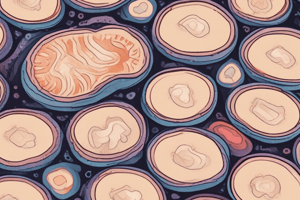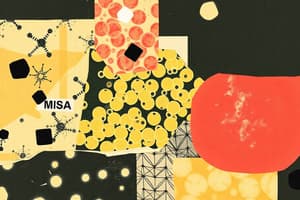Podcast
Questions and Answers
Which characteristic is crucial for differentiating Salmonella from other Gram-negative bacteria on MacConkey's agar?
Which characteristic is crucial for differentiating Salmonella from other Gram-negative bacteria on MacConkey's agar?
- Production of indole
- Ability to produce spores
- Fermentation of lactose
- Inability to ferment lactose (correct)
A patient presents with symptoms of high fever, abdominal pain, and rose spots. Which type of Salmonella is MOST likely the cause?
A patient presents with symptoms of high fever, abdominal pain, and rose spots. Which type of Salmonella is MOST likely the cause?
- Salmonella typhi (correct)
- Salmonella enteritidis
- Salmonella choleraesuis
- Salmonella typhimurium
Following a community picnic, several attendees develop gastroenteritis. Which Salmonella serotype is the MOST probable cause of this outbreak?
Following a community picnic, several attendees develop gastroenteritis. Which Salmonella serotype is the MOST probable cause of this outbreak?
- Salmonella Typhi
- Salmonella Choleraesuis
- Salmonella Typhimurium (correct)
- Salmonella Paratyphi
A patient is diagnosed with septicemia following a severe gastrointestinal infection. Which Salmonella serotype is MOST likely responsible for this systemic condition?
A patient is diagnosed with septicemia following a severe gastrointestinal infection. Which Salmonella serotype is MOST likely responsible for this systemic condition?
How would you BEST describe Salmonella's motility and ability to form spores?
How would you BEST describe Salmonella's motility and ability to form spores?
Why is dilution a crucial step in blood cultures for diagnosing bacteremia and typhoid fever?
Why is dilution a crucial step in blood cultures for diagnosing bacteremia and typhoid fever?
During which week of enteric fever is a blood culture most likely to yield a positive result for Salmonella?
During which week of enteric fever is a blood culture most likely to yield a positive result for Salmonella?
What characteristic of Salmonella colonies on MacConkey's medium aids in their preliminary identification during stool culture?
What characteristic of Salmonella colonies on MacConkey's medium aids in their preliminary identification during stool culture?
How do selenite broth and tetrathionate broth enhance Salmonella isolation from stool samples?
How do selenite broth and tetrathionate broth enhance Salmonella isolation from stool samples?
Which of the following methods is used to concentrate bacteria from urine samples before culturing to detect urinary Salmonella carriers?
Which of the following methods is used to concentrate bacteria from urine samples before culturing to detect urinary Salmonella carriers?
In the diagnosis of enteric fever, why is the Widal test more relevant during the second week of infection compared to the first?
In the diagnosis of enteric fever, why is the Widal test more relevant during the second week of infection compared to the first?
Why are individuals who are fecal carriers of Salmonella considered a public health concern?
Why are individuals who are fecal carriers of Salmonella considered a public health concern?
A patient is suspected of having enteric fever but blood cultures taken on the first day were negative. When would be the MOST appropriate time to perform a stool or urine culture to isolate Salmonella?
A patient is suspected of having enteric fever but blood cultures taken on the first day were negative. When would be the MOST appropriate time to perform a stool or urine culture to isolate Salmonella?
A lab technician notices that the MacConkey agar plate inoculated with a stool sample shows a high number of lactose-fermenting colonies. What does this observation suggest about the presence of Salmonella?
A lab technician notices that the MacConkey agar plate inoculated with a stool sample shows a high number of lactose-fermenting colonies. What does this observation suggest about the presence of Salmonella?
Which of the following statements accurately differentiates between the roles of blood, stool, and urine cultures in diagnosing Salmonella infections?
Which of the following statements accurately differentiates between the roles of blood, stool, and urine cultures in diagnosing Salmonella infections?
A public health investigation reveals a Salmonella outbreak linked to contaminated poultry. What follow-up steps are MOST crucial for preventing future occurrences?
A public health investigation reveals a Salmonella outbreak linked to contaminated poultry. What follow-up steps are MOST crucial for preventing future occurrences?
A researcher is investigating the genetic differences between Salmonella typhi and Salmonella typhimurium. Which genetic characteristic is MOST likely to be a key determinant in their differing pathogenic mechanisms?
A researcher is investigating the genetic differences between Salmonella typhi and Salmonella typhimurium. Which genetic characteristic is MOST likely to be a key determinant in their differing pathogenic mechanisms?
In a clinical setting, a patient presents with symptoms suggestive of enteric fever, but initial blood cultures are negative. What is the MOST appropriate next step in diagnosing a Salmonella infection?
In a clinical setting, a patient presents with symptoms suggestive of enteric fever, but initial blood cultures are negative. What is the MOST appropriate next step in diagnosing a Salmonella infection?
A microbiology lab is tasked with differentiating between Salmonella enteritidis and Escherichia coli colonies on a MacConkey agar plate. What is the MOST reliable characteristic to distinguish Salmonella colonies?
A microbiology lab is tasked with differentiating between Salmonella enteritidis and Escherichia coli colonies on a MacConkey agar plate. What is the MOST reliable characteristic to distinguish Salmonella colonies?
Why is it crucial to perform antimicrobial susceptibility testing on Salmonella isolates from patients diagnosed with systemic infections like septicemia?
Why is it crucial to perform antimicrobial susceptibility testing on Salmonella isolates from patients diagnosed with systemic infections like septicemia?
In a community outbreak of salmonellosis linked to a contaminated water source, what is the MOST effective measure to prevent further spread, considering both fecal and urinary carriers?
In a community outbreak of salmonellosis linked to a contaminated water source, what is the MOST effective measure to prevent further spread, considering both fecal and urinary carriers?
A patient is suspected of having enteric fever, but initial blood cultures are negative. If the patient is in their third week of illness, which sample type provides the BEST chance of isolating Salmonella?
A patient is suspected of having enteric fever, but initial blood cultures are negative. If the patient is in their third week of illness, which sample type provides the BEST chance of isolating Salmonella?
Why is it essential to use selective media like MacConkey's medium after enrichment in selenite or tetrathionate broth when isolating Salmonella from stool samples?
Why is it essential to use selective media like MacConkey's medium after enrichment in selenite or tetrathionate broth when isolating Salmonella from stool samples?
A lab technician observes numerous lactose-fermenting colonies on MacConkey agar after culturing a stool sample. What should be the NEXT step to confirm or rule out the presence of Salmonella?
A lab technician observes numerous lactose-fermenting colonies on MacConkey agar after culturing a stool sample. What should be the NEXT step to confirm or rule out the presence of Salmonella?
In diagnosing bacteremia associated with typhoid fever, what is the PRIMARY reason for diluting blood samples before culturing?
In diagnosing bacteremia associated with typhoid fever, what is the PRIMARY reason for diluting blood samples before culturing?
If a patient is suspected of being a urinary carrier of Salmonella, what laboratory procedure is crucial for maximizing the chances of isolating the bacteria from a urine sample?
If a patient is suspected of being a urinary carrier of Salmonella, what laboratory procedure is crucial for maximizing the chances of isolating the bacteria from a urine sample?
During an investigation of a salmonellosis outbreak, public health officials identify several individuals as fecal carriers. What measure is MOST important to prevent further transmission from these carriers?
During an investigation of a salmonellosis outbreak, public health officials identify several individuals as fecal carriers. What measure is MOST important to prevent further transmission from these carriers?
A patient presents with suspected enteric fever. Blood cultures are negative in the first week. Which diagnostic approach is MOST appropriate during the second week of illness?
A patient presents with suspected enteric fever. Blood cultures are negative in the first week. Which diagnostic approach is MOST appropriate during the second week of illness?
Upon reviewing culture results, a microbiologist notes growth in selenite broth but observes no colonies on the subsequent MacConkey agar plate. What is the MOST likely explanation for this discrepancy?
Upon reviewing culture results, a microbiologist notes growth in selenite broth but observes no colonies on the subsequent MacConkey agar plate. What is the MOST likely explanation for this discrepancy?
How does tetrathionate broth selectively enhance Salmonella isolation from stool samples containing a mixed population of bacteria?
How does tetrathionate broth selectively enhance Salmonella isolation from stool samples containing a mixed population of bacteria?
Which of the following is a key characteristic of Salmonella?
Which of the following is a key characteristic of Salmonella?
What color are Salmonella colonies typically on MacConkey's medium?
What color are Salmonella colonies typically on MacConkey's medium?
Which characteristic is NOT typical of Salmonella?
Which characteristic is NOT typical of Salmonella?
What type of disease is commonly associated with nontyphoidal Salmonella?
What type of disease is commonly associated with nontyphoidal Salmonella?
Which Salmonella species is known to cause enteric fever?
Which Salmonella species is known to cause enteric fever?
Which of the following mediums is used to enhance Salmonella isolation from stool samples?
Which of the following mediums is used to enhance Salmonella isolation from stool samples?
What is the purpose of centrifuging urine samples when trying to identify urinary carriers of Salmonella?
What is the purpose of centrifuging urine samples when trying to identify urinary carriers of Salmonella?
What type of culture is the primary diagnostic tool in the first week of enteric fever?
What type of culture is the primary diagnostic tool in the first week of enteric fever?
What is a key characteristic of Salmonella colonies on MacConkey's medium that aids in preliminary identification?
What is a key characteristic of Salmonella colonies on MacConkey's medium that aids in preliminary identification?
During which week of enteric fever does the Widal test become most relevant for diagnosis?
During which week of enteric fever does the Widal test become most relevant for diagnosis?
What is the primary reason fecal carriers of Salmonella are considered a public health concern?
What is the primary reason fecal carriers of Salmonella are considered a public health concern?
In which week of enteric fever is a stool or urine culture most useful for isolating Salmonella?
In which week of enteric fever is a stool or urine culture most useful for isolating Salmonella?
Which enrichment medium is commonly used to inhibit the growth of other bacteria while allowing Salmonella to thrive?
Which enrichment medium is commonly used to inhibit the growth of other bacteria while allowing Salmonella to thrive?
What is the purpose of using selective media like MacConkey's medium in Salmonella isolation?
What is the purpose of using selective media like MacConkey's medium in Salmonella isolation?
Flashcards
Salmonella Key Features
Salmonella Key Features
Gram-negative, motile bacilli that do not form capsules or spores.
Salmonella on MacConkey
Salmonella on MacConkey
On MacConkey's medium, they produce pale yellow colonies because they cannot ferment lactose.
Typhoidal Salmonella diseases
Typhoidal Salmonella diseases
Cause enteric fever, including typhoid fever (S. typhi) and paratyphoid fever (S. paratyphi A, B, C).
Nontyphoidal Salmonella diseases
Nontyphoidal Salmonella diseases
Signup and view all the flashcards
Salmonella choleraesuis
Salmonella choleraesuis
Signup and view all the flashcards
Fecal Carriers
Fecal Carriers
Signup and view all the flashcards
Urinary Carriers
Urinary Carriers
Signup and view all the flashcards
Blood Culture (Week 1)
Blood Culture (Week 1)
Signup and view all the flashcards
Widal Test (Week 2)
Widal Test (Week 2)
Signup and view all the flashcards
Stool/Urine Culture (Week 3)
Stool/Urine Culture (Week 3)
Signup and view all the flashcards
Blood Dilution Technique
Blood Dilution Technique
Signup and view all the flashcards
Advantage of Dilution
Advantage of Dilution
Signup and view all the flashcards
Enrichment Medium
Enrichment Medium
Signup and view all the flashcards
Selenite Broth
Selenite Broth
Signup and view all the flashcards
Tetrathionate Broth
Tetrathionate Broth
Signup and view all the flashcards
Typhoidal Salmonella
Typhoidal Salmonella
Signup and view all the flashcards
Nontyphoidal Salmonella
Nontyphoidal Salmonella
Signup and view all the flashcards
Bacteremia
Bacteremia
Signup and view all the flashcards
Septicemia
Septicemia
Signup and view all the flashcards
Gram-Negative Bacilli
Gram-Negative Bacilli
Signup and view all the flashcards
Salmonella Fecal Carriers
Salmonella Fecal Carriers
Signup and view all the flashcards
Salmonella Urinary Carriers
Salmonella Urinary Carriers
Signup and view all the flashcards
Blood Sample Dilution
Blood Sample Dilution
Signup and view all the flashcards
Advantage of Blood Dilution
Advantage of Blood Dilution
Signup and view all the flashcards
Stool Enrichment
Stool Enrichment
Signup and view all the flashcards
Optimal Incubation Temp
Optimal Incubation Temp
Signup and view all the flashcards
Subculturing
Subculturing
Signup and view all the flashcards
Colony Confirmation
Colony Confirmation
Signup and view all the flashcards
Urine Centrifugation
Urine Centrifugation
Signup and view all the flashcards
Urine Culture Method
Urine Culture Method
Signup and view all the flashcards
Salmonella: Key ID features
Salmonella: Key ID features
Signup and view all the flashcards
Salmonella Color on MacConkey
Salmonella Color on MacConkey
Signup and view all the flashcards
Selenite Broth Function
Selenite Broth Function
Signup and view all the flashcards
Tetrathionate Broth Function
Tetrathionate Broth Function
Signup and view all the flashcards
Urine Centrifugation Purpose
Urine Centrifugation Purpose
Signup and view all the flashcards
Urine Culture Process
Urine Culture Process
Signup and view all the flashcards
Stool Enrichment Purpose
Stool Enrichment Purpose
Signup and view all the flashcards
Enrichment Medium Incubation
Enrichment Medium Incubation
Signup and view all the flashcards
Blood Dilution Advantage
Blood Dilution Advantage
Signup and view all the flashcards
Second Week Testing
Second Week Testing
Signup and view all the flashcards
Initial Diagnosis Method
Initial Diagnosis Method
Signup and view all the flashcards




